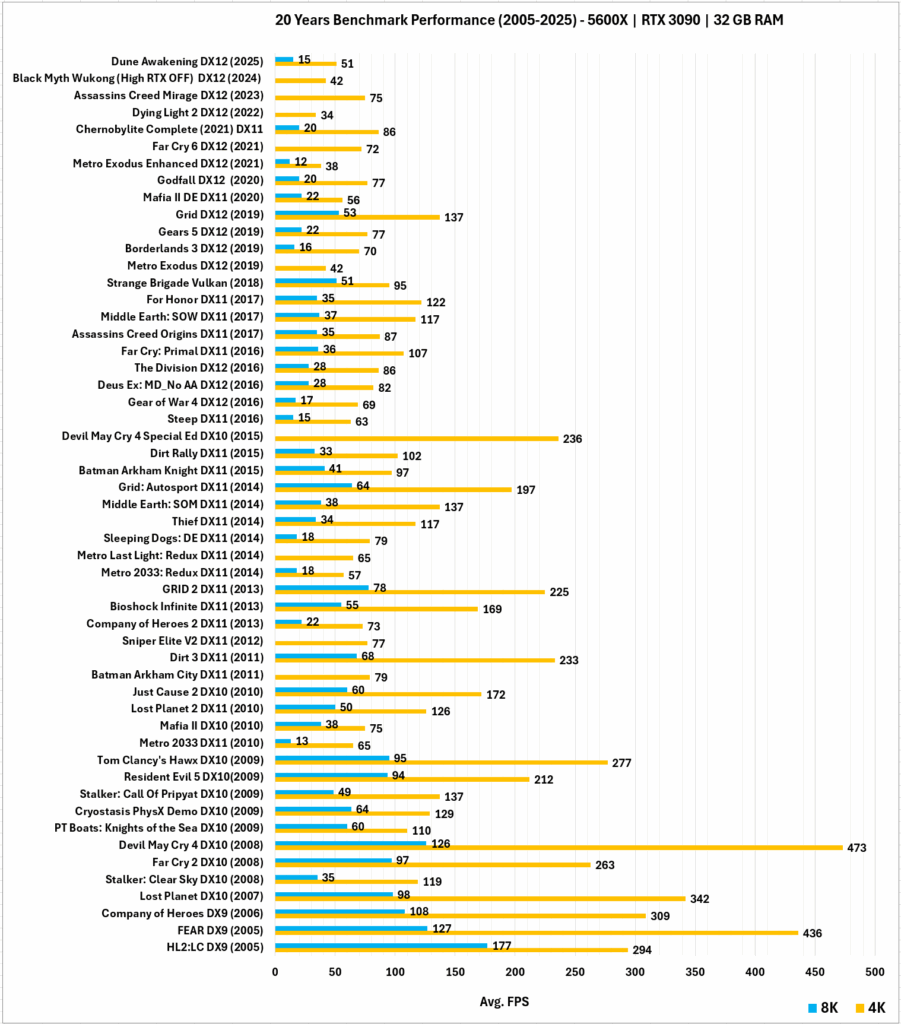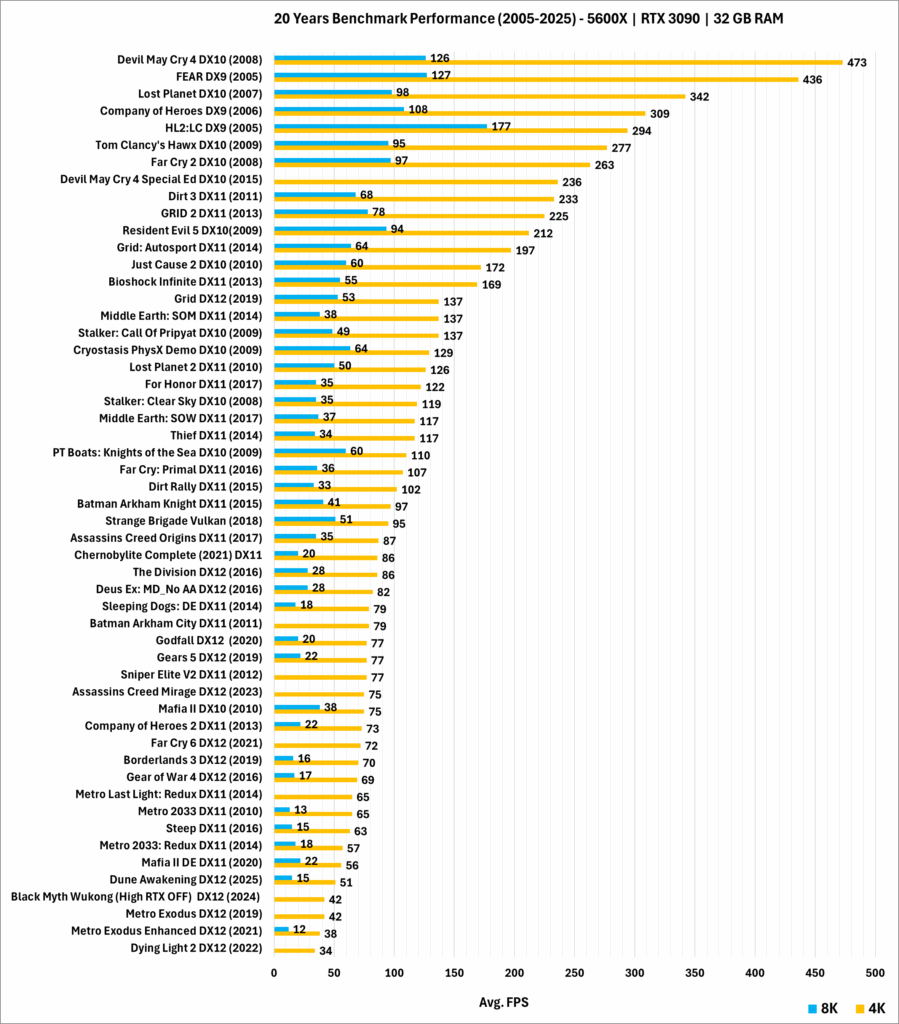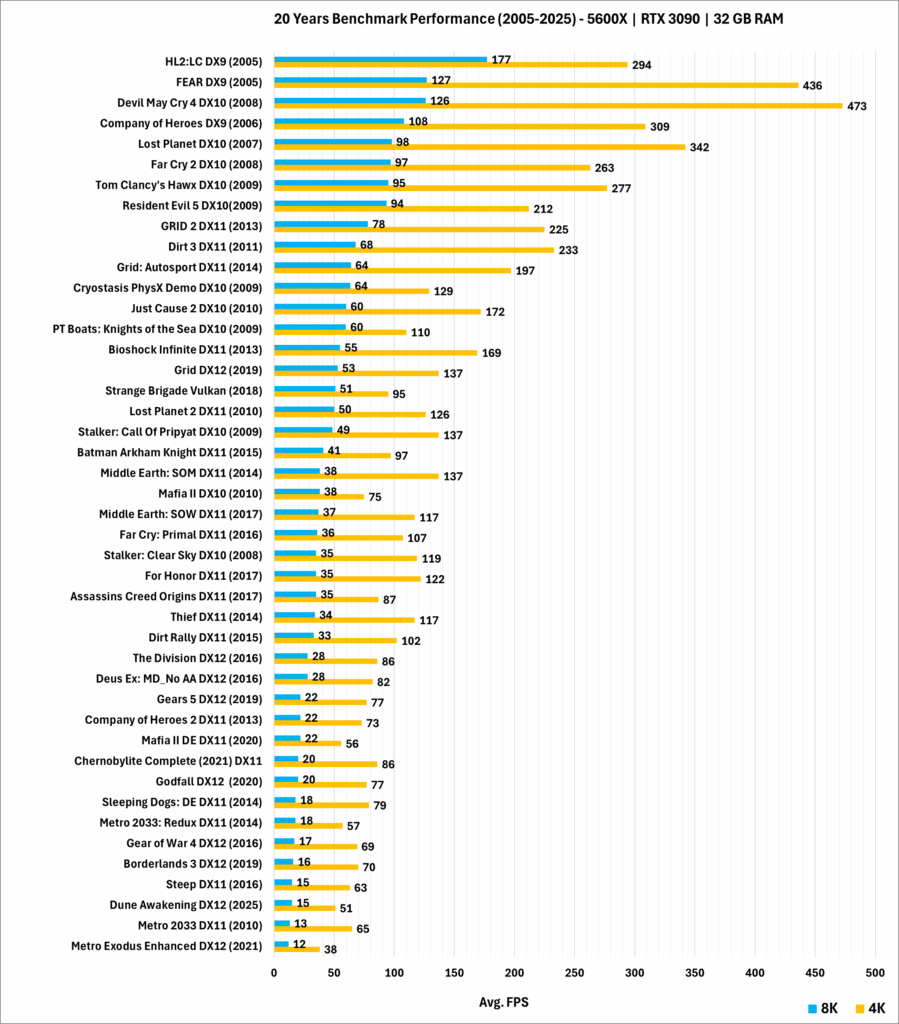
Introduction
I’ve been benchmarking PC games since 2005. My first build was an AMD Athlon 3200+ with an NVIDIA 6600 GT. Today I’m on a Ryzen 9950X with an RTX 3090—hardware that’s on a completely different level. On average, the 9950X is about 2,400% faster than the Athlon 3200+, and the RTX 3090 is nearly 43,000% faster than the 6600 GT!
To celebrate two decades of benchmarking, I decided to revisit a selection of tests I’ve run over the years and see how they perform on modern hardware. This project took several months to complete, and during that time I actually swapped CPUs—from a Ryzen 5600X to the 9950X. In this article, all of the benchmark numbers are from the 5600X system. I’ll cover the CPU comparison in a separate article.
Test System
CPU: Ryzen 5600X
GPU: Nvidia Asus Stix RTX 3090 OC
Motherboard: ASROCK X570 Phantom Gaming AM4
RAM: CORSAIR – VENGEANCE LPX 32GB (2x16GB) DDR4 3600MHz 18-22-22-42
Games Tested
I focused only on games with repeatable built-in or standalone benchmark tools, running at least one benchmark from every year between 2005 and 2025, for a total of 52 benchmarks. Every test was run at the highest settings unless otherwise noted, with DLSS always disabled. All benchmarks were run at 4K, and most were also run at 8K. There’s something especially satisfying about rerunning benchmarks that once pushed my 2005 rig to the limit, and watching them fly today—like revisiting an RPG boss fight years later after leveling up your character.
Games tested – Sorted by Year of Release
Here are the games that we tested sorted by year.
Across the 52 benchmarks, the evolution of graphics APIs is clear. The journey begins with DirectX 9, represented by 3 games from 2005–2006 such as Half-Life 2: Lost Coast and F.E.A.R..
The late 2000s brought DirectX 10, which makes up 11 benchmarks between 2007 and 2015, including Lost Planet, Stalker: Clear Sky, and Resident Evil 5.
By 2010, DirectX 11 took over, dominating the benchmark history with 23 titles from 2010 through 2021 — ranging from Metro 2033 to Assassin’s Creed Origins and Far Cry 6.
From 2016 onward, the focus shifted to DirectX 12, which accounts for 14 benchmarks, starting with Gears of War 4 and continuing through recent releases like Black Myth Wukong (2024) and Dune Awakening (2025).
There’s also a single Vulkan benchmark — Strange Brigade (2018) — included to highlight one of the rare games that shipped with native Vulkan support.
2005
- Half Life 2: Lost Coast DX9
- FEAR DX9 (Benchmark Video)
2006
- Company of Heroes DX9
2007
2008
- Stalker: Clear Sky DX10
- Far Cry 2 DX10
- Devil May Cry 4 DX10
2009
- PT Boats: Knights of the Sea DX10
- Cryostasis PhysX Demo DX10
- Stalker: Call Of Pripyat DX10
- Resident Evil 5 DX10
- Tom Clancy’s HAWX DX10
2010
- Metro 2033 DX11
- Mafia II DX10
- Lost Planet 2 DX11
- Just Cause 2 DX10
2011
- Batman Arkham City DX11
- Dirt 3 DX11
2012
- Sniper Elite V2 DX11
2013
- Company of Heroes 2 DX11
- Bioshock Infinite DX11
- GRID 2 DX11
2014
- Metro 2033: Redux DX11
- Metro Last Light: Redux DX11
- Sleeping Dogs: DE DX11
- Thief DX11
- Middle Earth: SOM DX11
- Grid: Autosport DX11
2015
- Batman Arkham Knight DX11
- Dirt Rally DX11
- Devil May Cry 4 Special Ed DX10
2016
- Steep DX11
- Gear of War 4 DX12
- Deus Ex: Mankind Divided No AA DX12
- The Division DX12
- Far Cry: Primal DX11
2017
- Assassins Creed Origins DX11
- Middle Earth: SOW DX11
- For Honor DX11
2018
2019
2020
- Mafia II DE DX11
- Godfall DX12
2021
- Metro Exodus Enhanced DX12
- Far Cry 6 DX12
- Chernobylite Complete DX11
2022
- Dying Light 2 DX12
2023
- Assassins Creed Mirage DX12
2024
- Black Myth Wukong (High Preset, RTX OFF) DX12
2025
- Dune Awakening DX12
Results Summary sorted by year:

Results Summary sorted by average FPS at 4K resolution:

Results Summary sorted by average FPS at 8K resolution:

There is a lot to digest in these plots – Here are some comments and observations:
FEAR (2005)
FEAR is one of the only three DirectX9 titles in our list (The others being Half Life 2: Lost Coast and Company of Heroes).
Even today, this 2005 classic remains one of the best—and most beloved—titles for benchmarking. It stood far ahead of its time in multiple areas, from enemy AI and gameplay mechanics to overall visual fidelity. Technically, it was groundbreaking: features like soft shadows (a notorious performance hog back then) set new standards and pushed PC gaming forward several notches. At launch, nothing else came close.
The built-in benchmark was ideal in both length and design, providing a thorough workout for system performance. What made it especially distinctive was its heavy reliance on GPU power relative to CPU strength, making it highly responsive to even small improvements in graphics hardware. During the heyday of multi-GPU setups, it offered some of the best scaling available—whether with SLI, CrossFire, or even triple-GPU (Tri-SLI) systems. Remarkably, that GPU sensitivity can still be seen today. At 4K resolution it averages 436 FPS (second only to Devil May Cry 4), far outperforming other titles from the same era, which are heavily bottlenecked by the 5600X CPU.
Devil May Cry 4 (2008)
I’ve never been a fan of the Devil May Cry series and haven’t actually played any of the games, yet DMC4 has become one of my most frequently used benchmarks. The built-in test is a bit longer than I’d like, and because the recorded sequences involve enemy AI, it isn’t perfectly repeatable. Even so, much like FEAR, it shines in its sensitivity to GPU performance—achieving the highest average FPS of all the titles tested at 4K.
What’s particularly interesting is that at 8K resolution, FEAR and DMC4 produce almost identical results, averaging around 127 FPS. Strangely, however, the DMC4 Special Edition—released seven years later—delivers barely more than half the average FPS at 4K, despite offering little to no noticeable visual improvements over the original.
Stalker: Clear Sky (2008)
The strange thing about this titles is how low it scores, especially at 8K – Only 35 FPS. It does not “look” that great – perhaps a case of severe CPU bottleneck as well as poor optimization.
The Metro Series (2010 – 2021)
As you can tell—given that all five major entries in the series appear in this list—the Metro franchise has long been a personal favorite for benchmarking, second only to FEAR. It’s more than deserving of a dedicated chart of its own.

The original metro 2033 released in 2010 was among the earliest adopters of DirectX 11. It still only gets 65 FPS at 4K, 15 years later. The latest Metro is currently one of the most demanding titles around.
Deus Ex: Mankind Divided (2016)
This game looks exceptional – The amount of visual detail in the benchmark sequence is stunning. It is amazing that it is almost ten years old at this point! In my opinion, despite its age it is still one of the best looking benchmark sequences available (for some reason AA completely breaks this benchmark – I ran it without AA getting 82 FPS at 4K and 28 at 8K).
Black Myth : Wukong (2024)
The demands this benchmark places on a system are almost absurd—it stands as the single most demanding title on our list. We even put together a dedicated article on it, diving into both its image quality settings and overall performance.
What about Crysis?
Anyone active in the benchmarking scene during the mid-2000s and early 2010s will instantly recognize Crysis. Released in 2007, it quickly became the definitive test of a system’s performance. The game included standalone GPU and CPU benchmarks that could be run outside the main campaign—though, somewhat ironically for a title renowned as a technical showcase, they were extremely barebones. Results were limited to min/max/average frame rates displayed in a command prompt window.
Unfortunately, I haven’t been able to get the original Crysis benchmarks running successfully on my current system. And, strangely—and a little disappointingly—none of the later Crysis entries ever shipped with official benchmark sequences.

Recent Comments